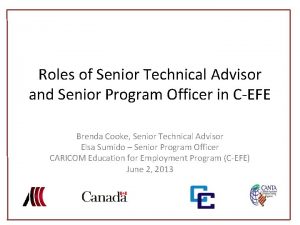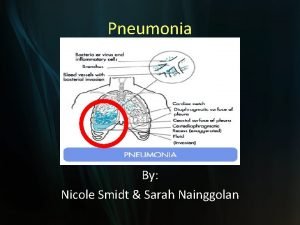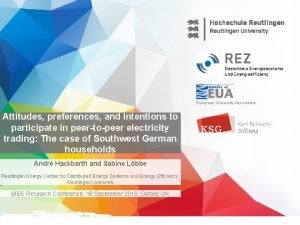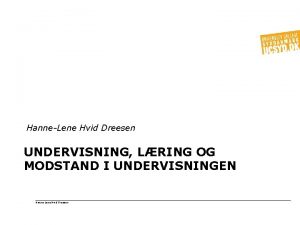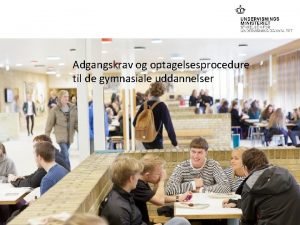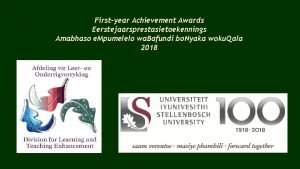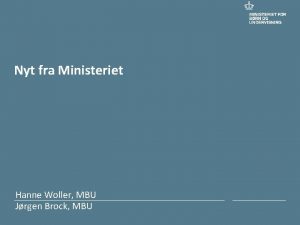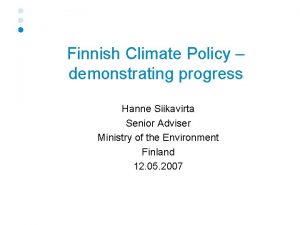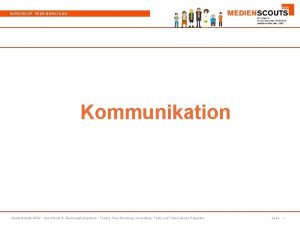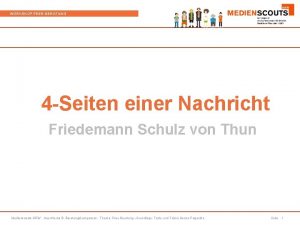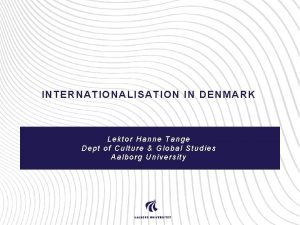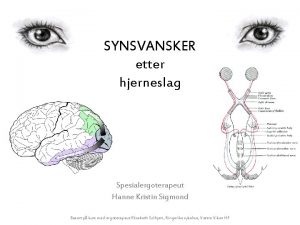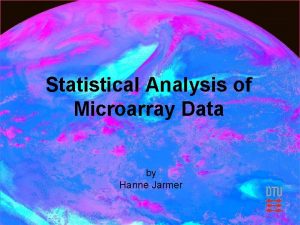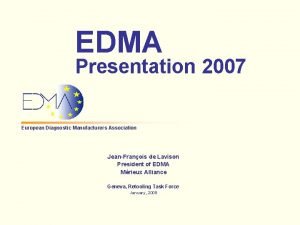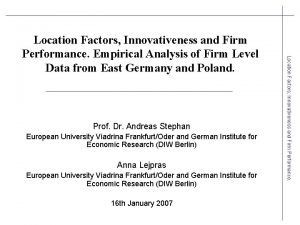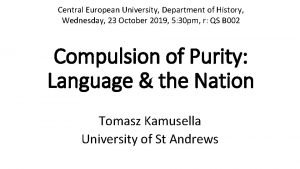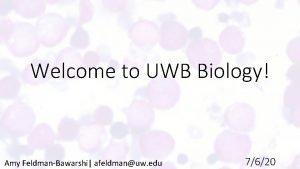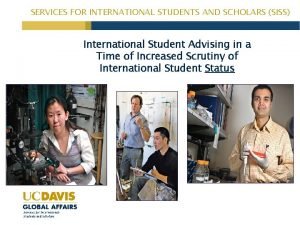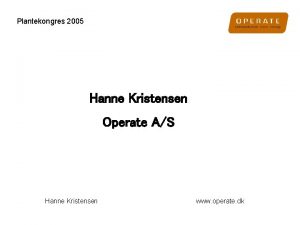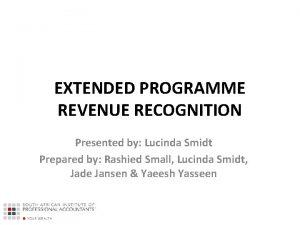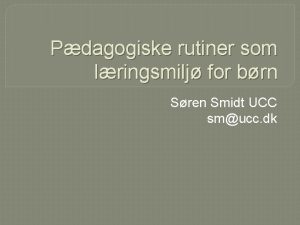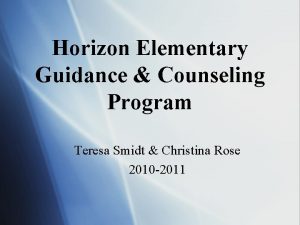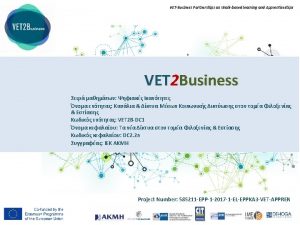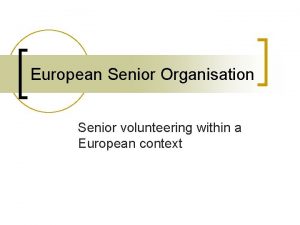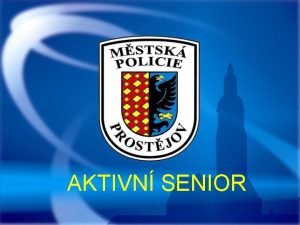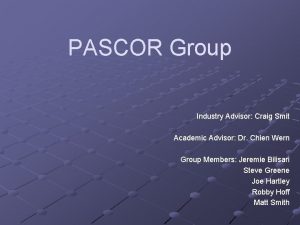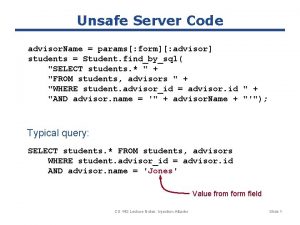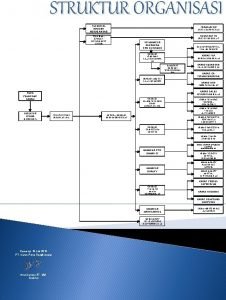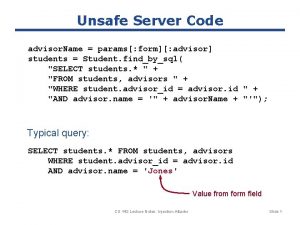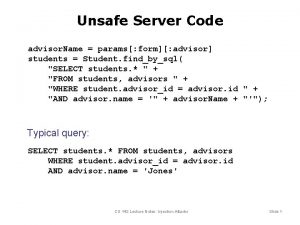Hanne Smidt Senior Advisor European University Association European































- Slides: 31

Hanne Smidt, Senior Advisor European University Association

European University Association • • • 34 Rectors’ conferences 850 members in 47 countries 3 members in Belarus: Belarussian National Technical University, The Belarussian State University Yanka Kupala State University Grodno

EUA – a unique actor 3 Hanne Smidt, EUA

Hanne Smidt, EUA

EUA works in five thematic areas – are all related to the interactive development of the EHEA • • • Learning and Teaching - Universities in the EHEA Research and Innovation – Universities in the ERA Internationalisation – European Universities in a Global Context Governance, Funding and Public Policy Development Institutional Development – Quality Assurance and targeted member services (IEP, CDE and the new ‘EUA Solutions’) Hanne Smidt, EUA

Studies • • Collaborative Doctoral Education: University-Industry Partnerships for Enhancing Knowledge Exchange Financially Sustainable Universities II: European Universities Diversifying Income Streams Global University Rankings and their Impact University Autonomy in Europe II – The Scorecard Hanne Smidt, EUA

For more information on the latest EUA activities and events visit: www. eua. be Hanne Smidt, EUA


HERE Portal Registration Calendar Dissemination of presentations & materials etc. Coming up: Discussion groups to prime events/follow-up video streaming events, webinars sharing experience between individuals and national teams email alerts Search for national communication & social media champions

About HERE • • HERE – initiative of the European Commission – implemented through the EACEA Agency Higher Education Reform Experts in Partner countries formerly: Bologna experts/promoters national Teams of HERE NEO = National Erasmus + Office http: //erasmusplus. am/ New contract: 2015 -2017 – SPHERE Consortium

Out line of presentation • • Interdisciplinarity in the EHEA Drivers for development Different terms The “Bologna master” often builds on interdisciplinarity Erasmus Mundus The Swedish Master study, 2010 Student learning outcomes Organisation at university level Hanne Smidt, EUA

Interdisciplinarity in European Higher Education Area • • Under development since the beginning of the 20 th century – and yet it seems new now Definitions emerged in the 1970’s Wide appeal and wide confusion Educators, researchers and practitioners have all turned to interdisciplinary work in order to accomplish a range of objectives: • To To To answer complex questions address broad issues explain disciplinary and professional relations solve problems beyond the scope of disciplines achieve unity of knowledge Linked with the development of the EHEA, competivieness and employability Hanne Smidt, EUA

”Subtle” restructuring of knowledge: New divisions of intellectual labor Collaborative research Team teaching Hybrid fileds Comparative studies Increased borrowing acriss fields = pressure upon traditional divisions of knowledge: Permeability of boundaries Blurring and mixing of genres = somethings is happening to” the way we think about the way we think” These pressures have many origins and serve many purposes and have all at one time or another been labled ”interdisciplinarity” Hanne Smidt, EUA

Drivers of interdisciplinarity is the Knowledge triangle Many ways to look at it… Hanne Smidt, EUA

Interdisciplinary programmes often address socital issues/problems Hanne Smidt, EUA

Different terms • Interdisciplinary: The process of combining two or more disciplines, fields of study or professions. , but is also attempting to synthesis them into something new. This sounds simple, which means it isn’t, mainly because, in the words of my supervisor, it’s like that Pollyanna character saying “Why can’t we all get along together? ” • Cross-disciplinary: Coordinated effort involving two or more academic disciplines. Finding a middle ground of sorts? • Multidisciplinary: Relating to, or making use of several disciplines at once. This acknowledges that there are differences between disciplines in “how the work is done”, but doesn’t have a way to bridge these differences. How do you know which discipline is more important at any one time? • Transdisciplinary (or postdisciplinary): approaches that transcend boundaries of contentional approaches this attempts to get around the issue of methods of thinking completely by working from the problem space out. Hanne Smidt, EUA

Multidisciplinarity (often) becomes interdisciplinary • • A multidisciplinary degree can be described as a liberal arts degree with quite seperate subjects A interdisciplinary degree requires that there is a: ”day-today interaction between the different disciplines. It requires, therefore, some learning of the other discipline’s basic language and the interchange in interactive mode of samples, ideas and research” Lattuca: ”Creating Interdisciplinarity, 2001 • In a European context the second cycle has been a vehicle for creating interdisciplinary 1 – 2 year master degrees addressing global challenges, specific local challenges or as a support for new research fields. Hanne Smidt, EUA

But the distinction is less important than how interdisciplinarity can support (HE) global and societal development Hanne Smidt, EUA

The development of interdisciplinarity has typically been at the Master level What is the Bologna Master? • Normally carrying ECTS 90 -120, of which at least 60 should be at Master level • Typical duration of one to two full-time equivalent years • Disciplinary content consistent with generic level descriptors • Curriculum design and pedagogy defined by learning outcomes • A recognised point of [re]-entry into the European labour market (EUA Survey of Master Degrees in Europe, Howard Davies, 2009) Hanne Smidt, EUA

The EUA Master Study from 2009 indicate that there is a: Diversity of provision • Taught Master courses with a strong professional development application, available in full-time, parttime, distance and mixed modes • Research-intensive Master programmes, integrated into innovation and knowledge transfer activities and functioning as pre-doctoral studies for the career researcher • Master-level courses of varying duration delivered mainly to returning learners on in-service, executive release or self-referral bases Hanne Smidt, EUA

There a variety of masters • • Consecutive, Conversion, European, Interdisciplinary International, Lifelong, Professional, Joint or Double degree Hanne Smidt, EUA

Example of names of degrees • • Dual master’s degree Joint master’s degree Double master’s degree Master’s International double Award Nordic master ERASMUS MUNDUS master’s Hanne Smidt, EUA

Masterportal September 2015 • • • 36, 258 Master’s degrees in 71 countries: on campus/blended/on line 1014 interdisciplinary degrees 870 interdisciplinary degrees in English 110 interdisciplinary degrees in France 91 interdisciplinary degrees in UK • • 138 ERASMUS MUNDUS courses 126 ERASMUS Joint Master degrees Source: www. mastersportal. eu Hanne Smidt, EUA

Examples of ERASMUS MUNDUS programmes Hanne Smidt, EUA

Drivers for curriculum development are the demand for new skills and competences • • • Creativity Critical thinking Communication Collaboration Problem solving abilities Entrepreneurship Project-based skills Information management skills Autonomy and strategic skills Multiculturalism Hanne Smidt, EUA

Example: The Swedish Master Study, 2010 • • • Master programmes have been developed on different initiatives deriving from a research area or a doctoral programme, from an existing bachelor programme or in consultation with outside stakeholders (enterprises or local/regional government). The number of master programmes is growing, as well as the number of registered students as can be seen from statistics both from the project and the national statistics published by the Swedish National Agency for Higher Education. The focus was to be internationally competitive and high focus on developing employability, but either with a national or international target group Hanne Smidt, EUA

Interdiciplinarity often demands new teaching modes and learning outcomes ”Interdisciplinarity is often a collaborative process. . An expert interdisciplinarian is one who is able to integrate the input of others to address an issue, which may include coordinating team members. This trait applies especially to interdisciplinarians engaged in technical and scientific studies that most commonly involve teamwork. ” Repko (2008) Hanne Smidt, EUA

”Softer” student learning outcomes Outcome 1 • Students develop critical thinking skills that would allow them to see the intellectual connections between disciplinary fields in their area of concentration. Links to University SLOs • University SLO 1: Students develop skills in critical thinking, clear and thoughtful communication, creative expression, and honest open inquiry. • University SLO 2: Students develop mastery of a specific major and an understanding of the connections among disciplines. Outcome 2 • Students develop an awareness of diverse peoples, cultures, and ideas, and appreciate the importance of engaging in lifelong interdisciplinary learning to become informed and responsible global citizens. Links to University SLOs • University SLO 3: Students develop respect for the differences among people and ideas, and learn to clarify and articulate their own values. • University SLO 6: Students are prepared to engage in lifelong learning. Outcome 3 • Students learn to develop linkages between their interdisciplinary intellectual inquiries and their own ethical positions in terms of contemporary challenges facing individuals, communities, and societies Links to University SLOs • University SLO 2: Students develop mastery of a specific major and an understanding of the connections among disciplines. • University SLO 6: Students are prepared to engage in lifelong learning. Hanne Smidt, EUA

Interdisciplinary learning outcomes typically include: (a) grounding in traditional disciplines, (b) integration and broad perspective, (c) teamwork, (d) interdisciplinary communication. (From Borrego & Newswander / Interdisciplinary Learning Outcomes) Hanne Smidt, EUA

Examples of organisation Lund University, Sweden • • • http: //www. lunduniversity. lu. se/about-lund-university http: //www. lunduniversity. lu. se/about/faculties-atlund-university http: //www. lunduniversity. lu. se/about/facultiesdepartments-centres/institutes-and-research-centres http: //www. iiiee. lu. se/education/mespom https: //sites. google. com/a/mespom. eu/mespomtheses/theses-defended-in-2012 Hanne Smidt, EUA

Suggestions for further reading Maura Borrego, Lynita K. Newswander: Definitions of Interdisciplinary Research: Toward Graduate-Level Interdisciplinary Learning Outcomes, In: The Review of Higher Education, Volume 34, Number 1, Fall 2010, pp. 61 -84 (Article), The Johns Hopkins University Press Lisa R. Lattuca Creating Interdisciplinarity: Interdisciplinary Research and Teaching Among College and University faculty (2001) Vanderbilt University Press Julie Thompson Klein: Interdisciplinarity: History, Theory, and Practice, 1990 Wayne State University Press Hanne Smidt, Ulf Dalnäs, Kristina Josefson, Maivor Sjölund: D 2. 1 The two-year master degree – combining Bologna reforms and internationalisation in Sweden. A study of the introduction of the Bologna reforms as one aspect of internationalisation, In: Internationalisation of Higher Eudaction, Raabe, 2010 Hanne Smidt, Ulf Dalnäs, Kristina Josefson, Maivor Sjölund: The Swedish Master Project: The introduction of the second cycle at three Swedish universities, 2010 http: //www. fba. uu. se/digital. Assets/128306_master. pdf Hanne Smidt, EUA
 Senior technical advisor
Senior technical advisor Lin evola smidt
Lin evola smidt Nicole smidt
Nicole smidt European university association
European university association Hanne-lene hvid dreesen
Hanne-lene hvid dreesen Personlig effektivitetsprogram
Personlig effektivitetsprogram Netprøver
Netprøver Hanne mertens
Hanne mertens Hanne woller
Hanne woller Hanne siikavirta
Hanne siikavirta Hanne poguntke
Hanne poguntke Hanne poguntke
Hanne poguntke Hanne tange
Hanne tange Hanne foss hansen
Hanne foss hansen Kvadrant hemianopsi
Kvadrant hemianopsi Hanne jarmer
Hanne jarmer Georgia senior living association
Georgia senior living association European diy retail association
European diy retail association European diagnostic manufacturers association
European diagnostic manufacturers association European biomass industry association
European biomass industry association European delirium association
European delirium association Johannes theiner
Johannes theiner European magnetism association
European magnetism association Dr andreas stephan
Dr andreas stephan European central university
European central university Configurer proxy uqam
Configurer proxy uqam Uwb degree audit
Uwb degree audit Umr plan advisor
Umr plan advisor Unc charlotte ap credit
Unc charlotte ap credit Fidelity advisor 529
Fidelity advisor 529 Ucdavis siss
Ucdavis siss What were the policies implemented by roxas
What were the policies implemented by roxas
